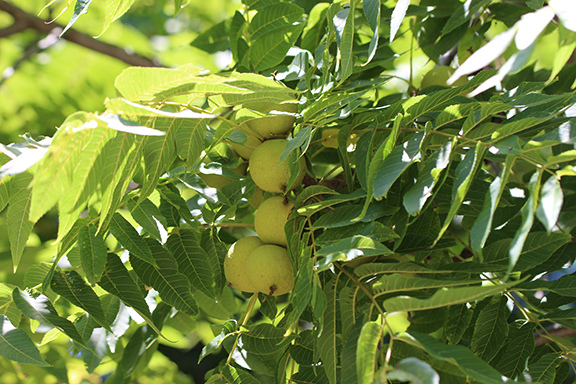Very few people realize that the Black Walnut has dozens of survival uses. Read below to learn more about the Black Walnut and it’s survival and bushcraft uses.
Scientific Name of the Plant: Juglans nigra.
Common Names of the Plant: Some common names for Juglans nigra include Black Walnut, Eastern Black Walnut, American Walnut, and simply Walnut.
Family of the Plant: Juglans nigra belongs to the family Juglandaceae.
Native Region: The Black Walnut is native to eastern North America, primarily in the United States and Canada. It is found in regions east of the Mississippi River, extending from southern Ontario, Canada, to Florida in the United States.

Historical Significance: Black Walnuts hold historical importance as a valuable resource for Indigenous peoples in North America. Native American tribes utilized various parts of the tree for sustenance and medicinal purposes. The nuts were a staple food source, and the wood was used for crafting tools and implements.
Survival Uses: The Black Walnut’s nuts are rich in calories and nutrients, making them a valuable survival food. The nuts could be stored for long periods, providing sustenance during harsh winters or challenging times.
First People Uses: Indigenous communities used Black Walnut tree parts extensively. They created poultices from the nut hulls to treat wounds, and the bark was used in traditional medicine. Additionally, the inner bark of young Black Walnut trees was woven into baskets.
Natural Herbicide: Black Walnut trees produce juglone, a chemical that can inhibit the growth of other plants nearby. Native peoples likely observed this effect and incorporated it into their horticultural practices.
Natural Insecticide: I’ve rubbed the leaves of Black Walnut on my skin numerous times as a mosquito repellent and it works quite well. (Test on wrist first for any reactions.)
Dye Production: Indigenous communities used the husks of Black Walnuts to create natural brown dyes for textiles and basketry, adding to the tree’s cultural significance.
Wildlife Habitat: Black Walnut trees provide essential habitat and food for wildlife. Squirrels, in particular, rely on these nuts as a primary food source during the fall and winter months.
In addition, Black walnut husks have been used historically for their potential antifungal and antibacterial properties. These properties are attributed to a compound called juglone, which is found in high concentrations in black walnut husks, leaves, and roots. Juglone has been shown to have antimicrobial effects, making it effective against various fungi and bacteria.
Historical references suggest that Native American tribes used black walnut husks to treat various infections and skin conditions. Early European settlers in North America also recognized the medicinal value of black walnut husks. They used them to make poultices, infusions, or tinctures to treat fungal skin infections, wounds, and even as a remedy for intestinal parasites.
Modern studies have supported these historical uses to some extent. Juglone has been studied for its potential antimicrobial properties in laboratory settings. It appears to inhibit the growth of certain fungi and bacteria by disrupting their cellular processes. Here is an article in the National Library of Medicine that explores the antibacterial properties of Black Walnuts: https://www.ncbi.nlm.nih.gov/pmc/articles/PMC6316014/
Dosages and methods of use can vary depending on the intended application. For topical use, you can prepare a poultice by grinding or crushing black walnut husks and mixing them with a small amount of water to create a paste. Apply this paste to the affected area, such as a fungal skin infection or a wound. For internal use, preparations like tinctures or capsules may be made or even purchased, but it’s essential to consult with a healthcare professional for guidance on proper dosages and safety precautions.
If you’d like to learn more about the Survival Uses of Black Walnut Trees, leaves, nuts, and more, you can download my 8-page Survival Skill Sheet on Black Walnuts here: https://www.creekstewart.com/survival-skill-training-sheet-sets/ybeczyd5fy4zwn5e8c3rxd1k3v2067




![Best Online Survival Courses [even a FREE one]](https://i1.wp.com/willowhavenoutdoor.com/wp-content/uploads/2020/11/best-online-survival-course-1.jpg?resize=150%2C150&ssl=1)





